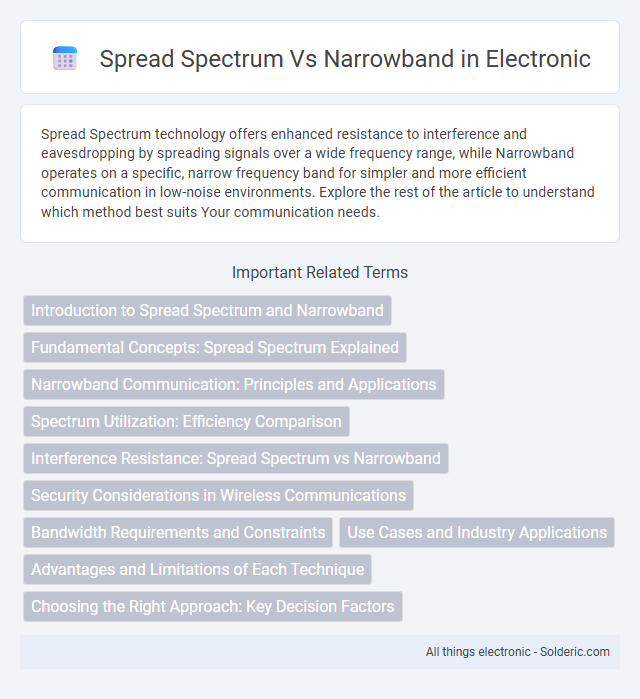Spread Spectrum technology offers enhanced resistance to interference and eavesdropping by spreading signals over a wide frequency range, while Narrowband operates on a specific, narrow frequency band for simpler and more efficient communication in low-noise environments. Explore the rest of the article to understand which method best suits Your communication needs.
Comparison Table
| Feature | Spread Spectrum | Narrowband |
|---|---|---|
| Frequency Bandwidth | Wide bandwidth, spreads signal over large frequency range | Uses narrow frequency range, limited bandwidth |
| Interference Resistance | High resistance to interference and jamming | More susceptible to interference and noise |
| Security | Better security due to signal spreading and scrambling | Lower security, easier to intercept |
| Power Efficiency | Generally lower power efficiency due to wide spectrum use | Higher power efficiency in focused narrow band |
| Data Rate | Can support high data rates with complex modulation | Typically supports lower data rates |
| Application Examples | GPS, Wi-Fi, military communication | AM/FM radio, traditional cellular networks |
| Complexity | Higher complexity in transmitter and receiver design | Lower design complexity |
Introduction to Spread Spectrum and Narrowband
Spread Spectrum technology transmits signals over a wide frequency range, enhancing resistance to interference, eavesdropping, and signal fading. Narrowband communication confines transmission within a narrow frequency band, optimizing power efficiency and bandwidth utilization for stable, long-distance communication. Both approaches serve distinct purposes in wireless communication systems, with Spread Spectrum excelling in robustness and security, while Narrowband prioritizes efficiency and simplicity.
Fundamental Concepts: Spread Spectrum Explained
Spread Spectrum technology distributes a signal across a wider frequency band than the minimum bandwidth required, enhancing resistance to interference, jamming, and eavesdropping. Narrowband communication confines the signal to a small, precise frequency range, optimizing power efficiency and simplicity but making it more vulnerable to narrowband interference. Key spread spectrum methods include Direct Sequence Spread Spectrum (DSSS) and Frequency Hopping Spread Spectrum (FHSS), both increasing bandwidth utilization to improve security and reliability in wireless systems.
Narrowband Communication: Principles and Applications
Narrowband communication operates by transmitting signals over a limited frequency range, offering high spectral efficiency and reduced interference in densely populated frequency environments. This method is ideal for applications requiring low data rates and long-range transmission, such as traditional voice communication, telemetry in industrial systems, and certain IoT devices. Your communication system benefits from narrowband principles when prioritizing energy efficiency and signal clarity in constrained bandwidth scenarios.
Spectrum Utilization: Efficiency Comparison
Spread spectrum technology uses a wider frequency band than narrowband, resulting in lower spectral efficiency but improved resistance to interference and eavesdropping. Narrowband systems concentrate signal power within a narrow frequency range, achieving higher spectral efficiency and better performance in bandwidth-limited environments. Despite narrowband's efficiency advantage, spread spectrum's robustness makes it preferable for secure and interference-prone communications.
Interference Resistance: Spread Spectrum vs Narrowband
Spread spectrum techniques significantly enhance interference resistance by spreading the signal across a wide frequency range, making it less susceptible to narrowband interference and jamming. Narrowband signals concentrate power in a small frequency band, which can make them more vulnerable to interference and signal degradation. Your communication system benefits from higher reliability and security when using spread spectrum methods, especially in noisy or congested environments.
Security Considerations in Wireless Communications
Spread spectrum techniques enhance wireless security by distributing the signal across a wider frequency band, making it more resistant to eavesdropping and jamming compared to narrowband. Narrowband systems concentrate energy in a narrow frequency range, which simplifies detection and interception by unauthorized users. Your wireless communications benefit from spread spectrum's inherent resistance to interference and unauthorized access, improving overall data confidentiality and integrity.
Bandwidth Requirements and Constraints
Spread spectrum technology requires significantly wider bandwidth than narrowband systems, often exceeding hundreds of kilohertz to several megahertz, to improve resistance to interference and eavesdropping. Narrowband systems use minimal bandwidth, typically a few kilohertz, optimizing spectral efficiency for applications with limited frequency availability or regulatory constraints. Your choice between the two depends on bandwidth availability and the need for robustness against noise, with spread spectrum excelling in complex and congested environments.
Use Cases and Industry Applications
Spread spectrum technology is widely used in military communications, GPS, and wireless networks due to its resistance to interference and eavesdropping, making it ideal for secure and reliable long-distance communication. Narrowband systems are prevalent in industries such as utility metering, industrial automation, and mobile radio, where bandwidth efficiency and signal clarity within specific frequency bands are prioritized. Both technologies serve critical roles; spread spectrum excels in complex, high-interference environments, whereas narrowband is favored for low-power, cost-effective applications with limited data throughput requirements.
Advantages and Limitations of Each Technique
Spread spectrum techniques provide enhanced resistance to interference, improved security, and better multipath fading mitigation, making them ideal for military and wireless communication applications. Their limitations include higher bandwidth consumption and increased complexity in transmitter and receiver design. Narrowband systems offer efficient use of bandwidth and simpler implementation, but suffer from susceptibility to narrowband interference and limited resilience to multipath fading.
Choosing the Right Approach: Key Decision Factors
Choosing between spread spectrum and narrowband communication depends on factors such as interference resistance, bandwidth availability, and power consumption. Spread spectrum excels in environments with high interference and security needs due to its wide frequency range and signal redundancy. Narrowband suits applications requiring low power and simpler hardware, provided the channel remains relatively interference-free.
Spread Spectrum vs Narrowband Infographic

 solderic.com
solderic.com